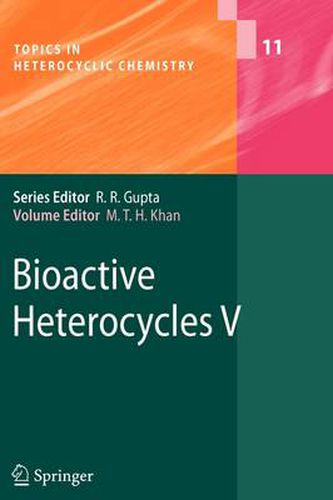Readings Newsletter
Become a Readings Member to make your shopping experience even easier.
Sign in or sign up for free!
You’re not far away from qualifying for FREE standard shipping within Australia
You’ve qualified for FREE standard shipping within Australia
The cart is loading…






This title is printed to order. This book may have been self-published. If so, we cannot guarantee the quality of the content. In the main most books will have gone through the editing process however some may not. We therefore suggest that you be aware of this before ordering this book. If in doubt check either the author or publisher’s details as we are unable to accept any returns unless they are faulty. Please contact us if you have any questions.
This volume contains 10 chapters. The contributions are from researchers - mousintheirrespective?eldsandthechapterscontainhighqualityreviewson topics related to the chemo-biologicalstudies of several different heterocyclic groups. The ?rst chapter from Saracoglu reviews the functionalization of indoles andthepyrrolesviaMichaeladditions,asthesecompoundshavepotential for their biologicalactivities. InsecondchapterMen’ endezreviewsthechemistryofthewelwitindolinones. Topcu and Demirkiran, in the third chapter, describe the chemistry and biological studies of lignans from Taxus species, including their biosynthesis andrecent strategiesforthesynthesisoflignans.Lignansareaveryimportant classofmolecules,astheyhaveaverydiversespectrumofbiologicalactivities, such as antitumour, antiviral, hepatoprotective, antioxidant, antiulcer, an- allergen, anti-platelet, and anti-osteoporoticactivities. InnextchapterSuzen .. describestheantioxidantactivitiesofsyntheticindole derivatives and their possible mechanisms of action. Inchapter?veGonz’ alezetal.presentsacomprehensivereviewonthech- istry and biology of the quinoxaline 1,4-dioxide and phenazine 5,10-dioxide typemolecules.Theyalsodiscussthemodeofaction,structure-activitystudies andother relevant chemical andbiologicalproperties forsuch molecules. Inthechaptersix,Khanbrie?ydiscussestheanti-angiogenicandtelomerase inhibitory activities of quinoline and its analogues. Liuet al.,inchapterseven, brie?y reviewssomeaspects ofstudies ofbio- tive marine sponge furanosesterterpenoids from the last 10 years, including their totalsyntheses. Pujol et al. in chapter eight, reviews the chemistry, origin and antiviral activities of naturally occurring sulfated polysaccharides for the prevention and controlof viral infections such as HIV-1 and -2, human cytomegalovirus (HCMV), dengue virus (DENV), respiratory syncytial virus (RSV), and - ?uenza Avirus. InchapternineHamdietal.describesthesynthesisandbiologicalactivities of the heterocyclicand vanillin ether coumarins. In the last chapter, Orhan et al. reviews their recent ?ndings on antiviral and antimicrobial heterocyclic compounds fromTurkish plants. Tromso,Norway 2007 Mahmud Tareq Hassan Khan Contents FunctionalizationofIndoleandPyrroleCores viaMichael-TypeAdditions N.Saracoglu …1 ChemistryoftheWelwitindolinones J.C.Menendez …63 LignansFrom TaxusSpecies G.Topcu*O.Demirkiran…103 AntioxidantActivities ofSyntheticIndoleDerivatives andPossibleActivity Mechanisms S.Suzen…1 45 Quinoxaline 1,4-DioxideandPhenazine5,10-Dioxide.
$9.00 standard shipping within Australia
FREE standard shipping within Australia for orders over $100.00
Express & International shipping calculated at checkout
This title is printed to order. This book may have been self-published. If so, we cannot guarantee the quality of the content. In the main most books will have gone through the editing process however some may not. We therefore suggest that you be aware of this before ordering this book. If in doubt check either the author or publisher’s details as we are unable to accept any returns unless they are faulty. Please contact us if you have any questions.
This volume contains 10 chapters. The contributions are from researchers - mousintheirrespective?eldsandthechapterscontainhighqualityreviewson topics related to the chemo-biologicalstudies of several different heterocyclic groups. The ?rst chapter from Saracoglu reviews the functionalization of indoles andthepyrrolesviaMichaeladditions,asthesecompoundshavepotential for their biologicalactivities. InsecondchapterMen’ endezreviewsthechemistryofthewelwitindolinones. Topcu and Demirkiran, in the third chapter, describe the chemistry and biological studies of lignans from Taxus species, including their biosynthesis andrecent strategiesforthesynthesisoflignans.Lignansareaveryimportant classofmolecules,astheyhaveaverydiversespectrumofbiologicalactivities, such as antitumour, antiviral, hepatoprotective, antioxidant, antiulcer, an- allergen, anti-platelet, and anti-osteoporoticactivities. InnextchapterSuzen .. describestheantioxidantactivitiesofsyntheticindole derivatives and their possible mechanisms of action. Inchapter?veGonz’ alezetal.presentsacomprehensivereviewonthech- istry and biology of the quinoxaline 1,4-dioxide and phenazine 5,10-dioxide typemolecules.Theyalsodiscussthemodeofaction,structure-activitystudies andother relevant chemical andbiologicalproperties forsuch molecules. Inthechaptersix,Khanbrie?ydiscussestheanti-angiogenicandtelomerase inhibitory activities of quinoline and its analogues. Liuet al.,inchapterseven, brie?y reviewssomeaspects ofstudies ofbio- tive marine sponge furanosesterterpenoids from the last 10 years, including their totalsyntheses. Pujol et al. in chapter eight, reviews the chemistry, origin and antiviral activities of naturally occurring sulfated polysaccharides for the prevention and controlof viral infections such as HIV-1 and -2, human cytomegalovirus (HCMV), dengue virus (DENV), respiratory syncytial virus (RSV), and - ?uenza Avirus. InchapternineHamdietal.describesthesynthesisandbiologicalactivities of the heterocyclicand vanillin ether coumarins. In the last chapter, Orhan et al. reviews their recent ?ndings on antiviral and antimicrobial heterocyclic compounds fromTurkish plants. Tromso,Norway 2007 Mahmud Tareq Hassan Khan Contents FunctionalizationofIndoleandPyrroleCores viaMichael-TypeAdditions N.Saracoglu …1 ChemistryoftheWelwitindolinones J.C.Menendez …63 LignansFrom TaxusSpecies G.Topcu*O.Demirkiran…103 AntioxidantActivities ofSyntheticIndoleDerivatives andPossibleActivity Mechanisms S.Suzen…1 45 Quinoxaline 1,4-DioxideandPhenazine5,10-Dioxide.